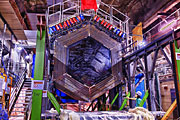- Number 360 |
- April 9, 2012
First message transmitted via neutrinos

The MINERvA detector.
Scientists have for decades contemplated communicating via neutrinos when other methods won’t do. For the first time, physicists and engineers have successfully transmitted a message through 240 meters of rock using the ghost-like particles.
“It’s beginning to look more feasible,” said Dan Stancil, professor of electrical and computer engineering at North Carolina State University, who had proposed the recent neutrino communication test. He collaborated with scientists of the MINERvA collaboration at DOE’s Fermi National Accelerator Laboratory, who use a 170-ton particle detector and a powerful, pulsed accelerator beam to produce neutrinos and measure their interactions with matter. Based on Stancil’s proposal, scientists were able to manipulate the pulsed beam and turn it for a couple of hours into a neutrino telegraph. “It’s impressive that the accelerator is flexible enough to do this,” said Fermilab physicist Debbie Harris, co-spokesperson of the MINERvA experiment.
For the actual test, scientists transmitted the word “neutrino.” The MINERvA detector decoded the message at 99 percent accuracy after just two repetitions of the signal. But until physicists create more intense neutrino beams or build better neutrino detectors, the goal of using neutrinos to communicate with people under the sea or outside Earth’s orbit will remain out of reach.
[Kurt Riesselmann, 630.840.5681,
kurtr@fnal.gov]
